
Brewster station is a commuter rail stop on the Metro-North Railroad's Harlem Line, located in Brewster, New York, United States.
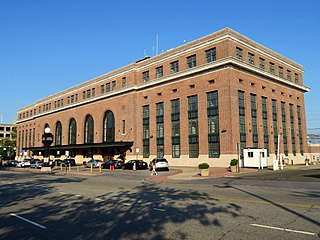
New Haven Union Station is the main railroad passenger station in New Haven, Connecticut. It is the third such station in the city of New Haven, preceded by both an 1848 built station in a different location, and an 1879 built station near the current station's location. Designed by noted American architect Cass Gilbert, the present beaux-arts Union Station was completed and opened in 1920 after the previous Union Station was destroyed by fire. It served the New York, New Haven and Hartford Railroad for the next five decades, but fell into decline following World War II along with the United States railroad industry as a whole.
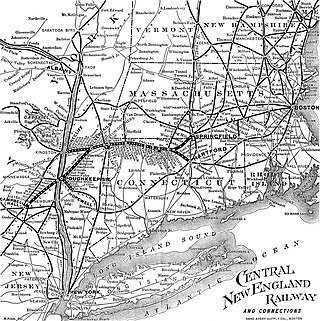
The Central New England Railway was a railroad from Hartford, Connecticut, and Springfield, Massachusetts, west across northern Connecticut and across the Hudson River on the Poughkeepsie Bridge to Maybrook, New York. It was part of the Poughkeepsie Bridge Route, an alliance between railroads for a passenger route from Washington to Boston, and was acquired by the New York, New Haven & Hartford Railroad in 1904. The New Haven ran the CNE as a separate company until finally merging it in 1927. The vast majority of the system was abandoned by the 1930s and 1940s. Surviving portions of the Central New England Railway are operated by the Central New England Railroad and the Housatonic Railroad.

The New York and New England Railroad (NY&NE) was a railroad connecting southern New York State with Hartford, Connecticut; Providence, Rhode Island; and Boston, Massachusetts. It operated under that name from 1873 to 1893. Prior to 1873 it was known as the Boston, Hartford and Erie Railroad, which had been formed from several smaller railroads that dated back to 1846. After a bankruptcy in 1893, the NY&NE was reorganized and briefly operated as the New England Railroad before being leased to the competing New York, New Haven and Hartford Railroad in 1898.

The Newburgh, Dutchess and Connecticut Railroad was a railroad in Dutchess County, New York, United States. Its line ran 58.9 miles (94.8 km) northeast from the Hudson River in Fishkill to the Connecticut state line near Millerton. The Dutchess and Columbia Railroad (D&C), was chartered in 1866 to link rural villages with the Hudson River Railroad and New York and Harlem Railroad. The under-construction line was leased by the Boston, Hartford and Erie Railroad (BH&E) in 1868. The first segment opened in July 1869, and it reached Pine Plains the following February.
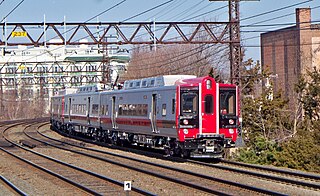
The New Haven Line is a 72.7 mi (117.0 km) commuter rail line operated by the Metro-North Railroad in the U.S. states of New York and Connecticut. Running from New Haven, Connecticut, to New York City, the New Haven Line joins the Harlem Line in Mount Vernon, New York, and continues south to Grand Central Terminal in Manhattan. The New Haven Line carries 125,000 passengers every weekday and 39 million passengers a year. The busiest intermediate station is Stamford, with 8.4 million passengers, or 21% of the line's ridership.

The Housatonic Railroad is a Class III railroad operating in southwestern New England and eastern New York. It was chartered in 1983 to operate a short section of ex-New York, New Haven and Hartford Railroad in northwestern Connecticut, and has since expanded north and south, as well as west into New York State.

The Danbury Branch is a diesel branch of the Metro-North Railroad's New Haven Line in the U.S. state of Connecticut, running from downtown Norwalk north to Danbury. It opened in 1852 as the Danbury and Norwalk Railroad. Until the early 1970s, passenger service continued north from Danbury to Canaan, Connecticut, and Pittsfield, Massachusetts. Metro-North took over operation of the line from Conrail in 1983, and the modern-day branch is mostly single-tracked.

The Naugatuck Railroad is a common carrier railroad owned by the Railroad Museum of New England and operated on tracks leased from the Connecticut Department of Transportation. The original Naugatuck Railroad was a railroad chartered to operate through south central Connecticut in 1845, with the first section opening for service in 1849. In 1887 the line was leased by the New York, New Haven and Hartford Railroad, and became wholly owned by 1906. At its greatest extent the Naugatuck ran from Bridgeport north to Winsted. Today's Naugatuck Railroad, formed in 1996, runs from Waterbury to the end of track in Torrington, Connecticut. From Waterbury south to the New Haven Line, Metro-North Railroad operates commuter service on the Waterbury Branch.
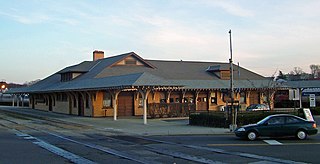
The Danbury Railway Museum is a railway museum housed in the former Union Station on the east end of downtown Danbury, Connecticut, United States. It was established in the mid-1990s following the closure of the station by the Metro-North Railroad in favor of a new station nearby, and primarily focuses on the history of railroading in southern New England and neighboring New York. In addition to the former station building, the museum has a collection of heritage railcars in the neighboring rail yard it shares with Metro-North.

Danbury station is a commuter rail station on the Danbury Branch of the Metro-North Railroad New Haven Line, located in Danbury, Connecticut. The station is the northern terminus of the Danbury Branch.

Bethel station is a commuter rail station on the Danbury Branch of the Metro-North Railroad New Haven Line, located in Bethel, Connecticut.
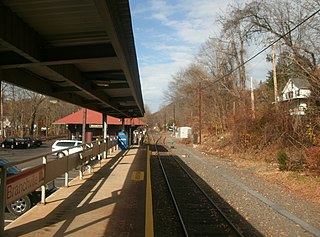
Branchville station is a commuter rail station on the Danbury Branch of the Metro-North Railroad New Haven Line, located in the Branchville neighborhood of Ridgefield, Connecticut.
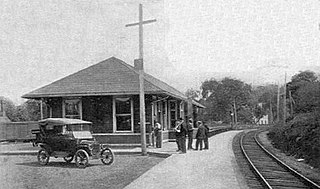
Georgetown station is a former commuter rail station on the Danbury Division of the New York, New Haven, and Hartford Railroad, located in Georgetown, Connecticut. It was in service from 1852 to 1970. A new station at Georgetown has been proposed.
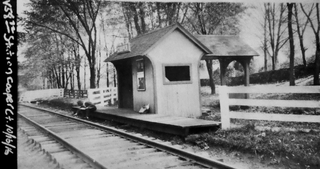
Cooper station was a stop on the Ridgefield Branch of the Danbury and Norwalk Railroad and later the New York, New Haven, and Hartford Railroad. Opened c. 1885 as a flag stop in the town of Ridgefield, Connecticut, the station was closed in 1925 when passenger service on the Ridgefield branch was discontinued. The station existed alongside the Florida and Ridgefield stations along the branch. Cooper was named so due to the namesake street it was located on which was in turn named for an unidentified cooper who operated a workshop in the vicinity.
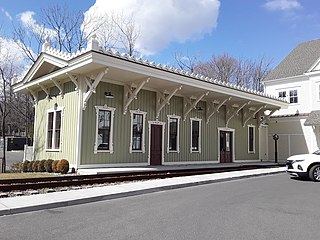
Ridgefield station was a station on the Ridgefield Branch of the Danbury and Norwalk Railroad and later the New York, New Haven, and Hartford Railroad, located in the town of Ridgefield, Connecticut. Opened in 1870 as the terminus of its namesake branch line. The station would serve passengers until the discontinuation of passenger service on August 8, 1925, afterwards only accommodating freight service until the NYNH&H abandoned the line entirely in 1964. The station would remain as a part of the Ridgefield Supply Company's headquarters until 2015, when the original station was disassembled, refurbished, and moved to the other side of the property where it still stands today.

Mill Plain is an unincorporated area in the City of Danbury, Connecticut, United States. It is located in the westernmost part of the city, bordering the town of Southeast, New York.
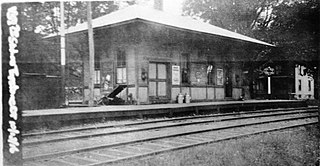
Sanford station was a passenger rail station on the Danbury and Norwalk Railroad and later the Danbury Branch of both the Housatonic Railroad and the New York, New Haven, and Hartford Railroad. The station was located on the border between Ridgefield and Redding, Connecticut, and was located on Topstone Road. Opened in 1852 as a flag stop and located in the Topstone section of Redding, Connecticut, the original station building was destroyed in 1891 by a speeding freight train. A new station building was erected the following year and would serve until the station's closure in 1938. The station was called so because of the numerous families named Sanford in the area surrounding the station.

Winnipauk was a station on the Danbury and Norwalk Railroad and later the Danbury Branch of the Housatonic Railroad and the New York, New Haven, and Hartford Railroad. Located in the Winnipauk section of the northern part of Norwalk, Connecticut, the station opened in 1852 and was an important stop that served nearby mills before it was closed in 1929.

The Ridgefield Branch was a branch line of the Danbury and Norwalk Railroad and later the New York, New Haven and Hartford Railroad. It ran for 4.0 miles (6.4 km) from Branchville to the center of Ridgefield, Connecticut. After a difficult and costly construction hindered by the topography of the Norwalk River valley, the branch opened in July 1870 after a year of construction. Throughout its existence, three stations existed on the line. In 1925, amid electrification of the neighboring Danbury Line, passenger service on the branch was terminated. Freight service continued to just the Ridgefield station until 1964, when the line was abandoned entirely.























